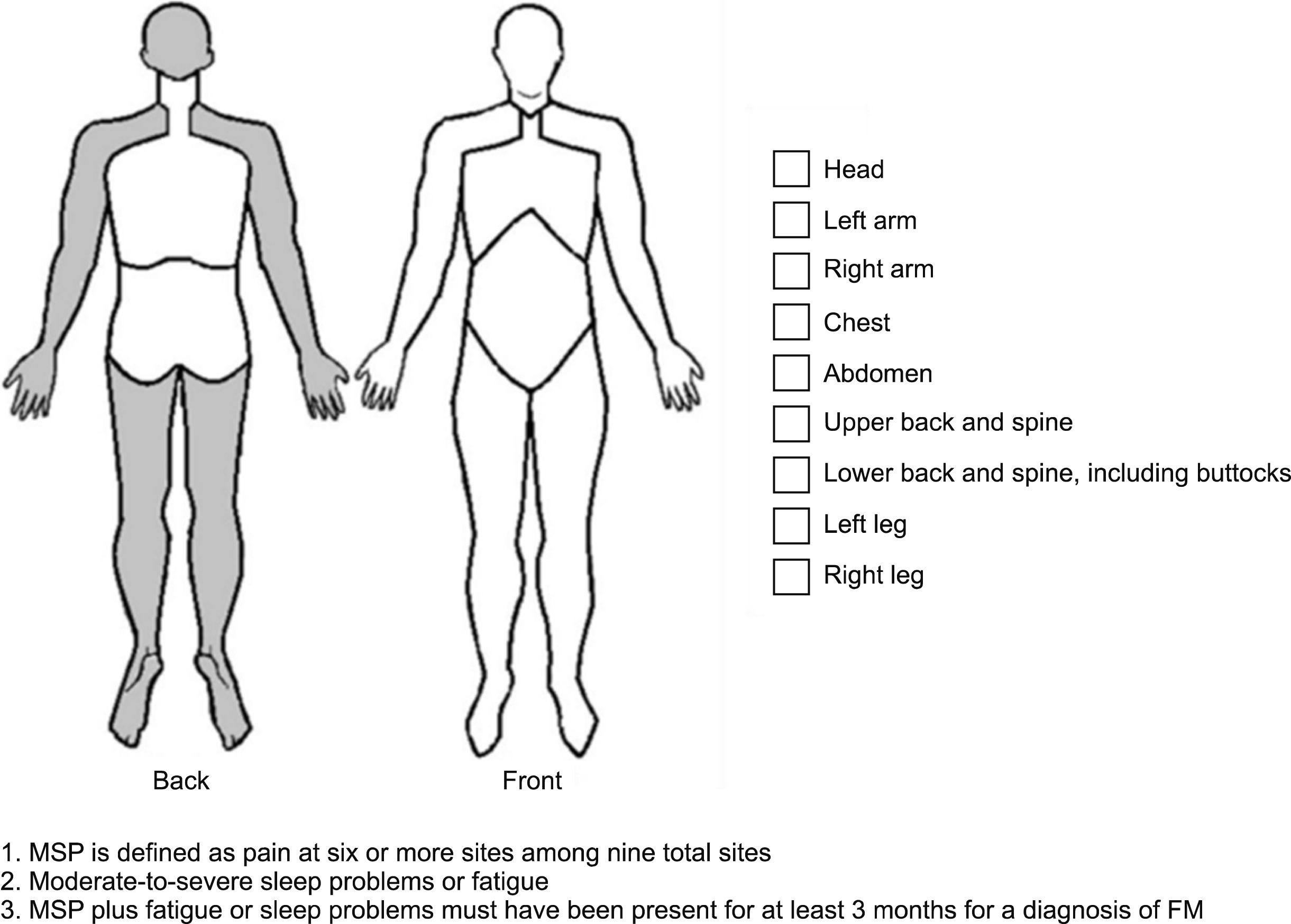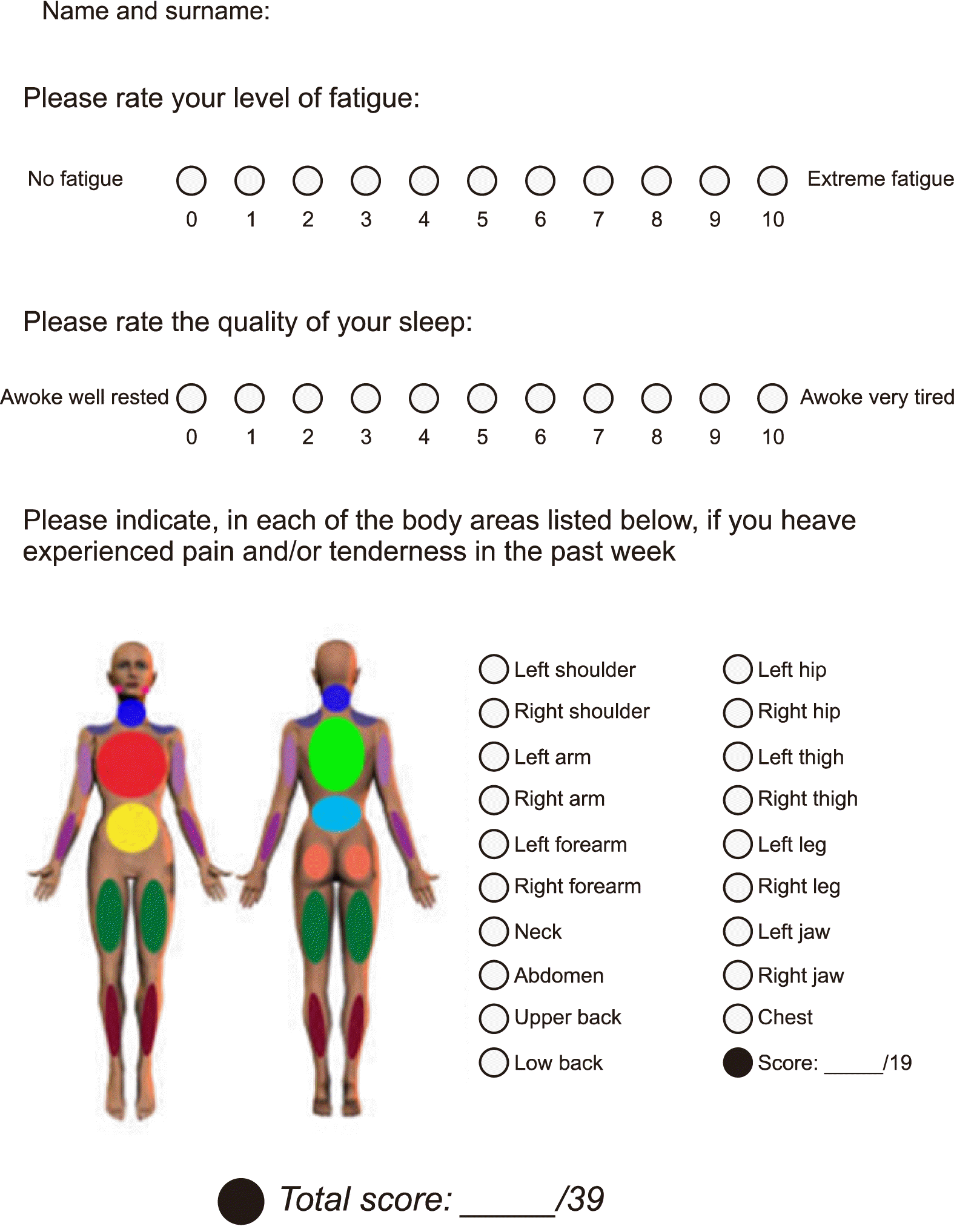1. Wolfe F, Clauw DJ, Fitzcharles MA, Goldenberg DL, Katz RS, Mease P, et al. 2010; The American College of Rheumatology preliminary diagnostic criteria for fibromyalgia and measurement of symptom severity. Arthritis Care Res (Hoboken). 62:600–10. DOI:
10.1002/acr.20140. PMID:
20461783.

2. Jones GT, Atzeni F, Beasley M, Flüß E, Sarzi-Puttini P, Macfarlane GJ. 2015; The prevalence of fibromyalgia in the general population: a comparison of the American College of Rheumatology 1990, 2010, and modified 2010 classification criteria. Arthritis Rheumatol. 67:568–75. DOI:
10.1002/art.38905. PMID:
25323744.

3. Choy E, Perrot S, Leon T, Kaplan J, Petersel D, Ginovker A, et al. 2010; A patient survey of the impact of fibromyalgia and the journey to diagnosis. BMC Health Serv Res. 10:102. DOI:
10.1186/1472-6963-10-102. PMID:
20420681. PMCID:
PMC2874550.

4. Kim SK, Kim SH, Lee CK, Lee HS, Lee SH, Park YB, et al. 2013; Effect of fibromyalgia syndrome on the health-related quality of life and economic burden in Korea. Rheumatology (Oxford). 52:311–20. DOI:
10.1093/rheumatology/kes255. PMID:
23024016.

5. Kosek E, Cohen M, Baron R, Gebhart GF, Mico JA, Rice ASC, et al. 2016; Do we need a third mechanistic descriptor for chronic pain states? Pain. 157:1382–6. DOI:
10.1097/j.pain.0000000000000507. PMID:
26835783.

6. Fitzcharles MA, Cohen SP, Clauw DJ, Littlejohn G, Usui C, Häuser W. 2021; Nociplastic pain: towards an understanding of prevalent pain conditions. Lancet. 397:2098–110. DOI:
10.1016/S0140-6736(21)00392-5.

7. Treede RD, Rief W, Barke A, Aziz Q, Bennett MI, Benoliel R, et al. 2019; Chronic pain as a symptom or a disease: the IASP Classification of Chronic Pain for the International Class-ification of Diseases (ICD-11). Pain. 160:19–27. DOI:
10.1097/j.pain.0000000000001384. PMID:
30586067.
8. Wolfe F, Smythe HA, Yunus MB, Bennett RM, Bombardier C, Goldenberg DL, et al. 1990; The American College of Rheumatology 1990 criteria for the classification of fibromyalgia. Report of the multicenter criteria committee. Arthritis Rheum. 33:160–72. DOI:
10.1002/art.1780330203. PMID:
2306288.
9. Wolfe F, Clauw DJ, Fitzcharles MA, Goldenberg DL, Häuser W, Katz RS, et al. 2011; Fibromyalgia criteria and severity scales for clinical and epidemiological studies: a modification of the ACR Preliminary Diagnostic Criteria for Fibromyalgia. J Rheumatol. 38:1113–22. DOI:
10.3899/jrheum.100594. PMID:
21285161.

10. Wolfe F, Clauw DJ, Fitzcharles MA, Goldenberg DL, Häuser W, Katz RL, et al. 2016; 2016 Revisions to the 2010/2011 fibromyalgia diagnostic criteria. Semin Arthritis Rheum. 46:319–29. DOI:
10.1016/j.semarthrit.2016.08.012. PMID:
27916278.

11. Macfarlane GJ, Kronisch C, Dean LE, Atzeni F, Häuser W, Fluß E, et al. 2017; EULAR revised recommendations for the management of fibromyalgia. Ann Rheum Dis. 76:318–28. DOI:
10.1136/annrheumdis-2016-209724. PMID:
27377815.

12. Choy EH, Arnold LM, Clauw DJ, Crofford LJ, Glass JM, Simon LS, et al. 2009; Content and criterion validity of the preliminary core dataset for clinical trials in fibromyalgia syndrome. J Rheumatol. 36:2330–4. DOI:
10.3899/jrheum.090368. PMID:
19820222. PMCID:
PMC3412585.

13. Fitzcharles MA, Boulos P. 2003; Inaccuracy in the diagnosis of fibromyalgia syndrome: analysis of referrals. Rheumatology (Oxford). 42:263–7. DOI:
10.1093/rheumatology/keg075. PMID:
12595620.

14. Smythe HA. 2011; Unhelpful criteria sets for "diagnosis" and "assessment of severity" of fibromyalgia. J Rheumatol. 38:975–8. DOI:
10.3899/jrheum.110142. PMID:
21632687.

15. Arnold LM, Bennett RM, Crofford LJ, Dean LE, Clauw DJ, Goldenberg DL, et al. 2019; AAPT diagnostic criteria for fibromyalgia. J Pain. 20:611–28. DOI:
10.1016/j.jpain.2018.10.008. PMID:
30453109.

16. Salaffi F, Di Carlo M, Farah S, Atzeni F, Buskila D, Ablin JN, et al. 2020; Diagnosis of fibromyalgia: comparison of the 2011/2016 ACR and AAPT criteria and validation of the modified Fibromyalgia Assessment Status. Rheumatology (Oxford). 59:3042–9. DOI:
10.1093/rheumatology/keaa061. PMID:
32206792.

17. Kang JH, Choi SE, Xu H, Park DJ, Lee JK, Lee SS. 2021; Comparison of the AAPT fibromyalgia diagnostic criteria and modified FAS criteria with existing ACR criteria for fibromyalgia in Korean patients. Rheumatol Ther. 8:1003–14. DOI:
10.1007/s40744-021-00318-8. PMID:
34021490. PMCID:
PMC8217352.

18. Clauw D. 2021; Time to stop the fibromyalgia criteria wars and refocus on identifying and treating individuals with this type of pain earlier in their illness. Arthritis Care Res (Hoboken). 73:613–6. DOI:
10.1002/acr.24198. PMID:
32248650.

19. Sommer C, Alten R, Bär KJ, Bernateck M, Brückle W, Friedel E, et al. 2017; [Drug therapy of fibromyalgia syndrome: updated guidelines 2017 and overview of systematic review articles]. Schmerz. 31:274–84. German. DOI:
10.1007/s00482-017-0207-0. PMID:
28493231.
20. Rivera Redondo J, Díaz Del Campo Fontecha P, Alegre de Miquel C, Almirall Bernabé M, Casanueva Fernández B, Castillo Ojeda C, et al. Recommendations by the Spanish Society of Rheumatology on fibromyalgia. Part 1: diagnosis and treatment. Reumatol Clin (Engl Ed) 2021 Oct 11 [Epub]. DOI:
10.1016/j.reumae.2021.02.002. PMID:
34649820.

21. Fitzcharles MA, Ste-Marie PA, Goldenberg DL, Pereira JX, Abbey S, Choinière M, et al. 2013; 2012 Canadian Guidelines for the diagnosis and management of fibromyalgia syndrome: executive summary. Pain Res Manag. 18:119–26. DOI:
10.1155/2013/918216. PMID:
23748251. PMCID:
PMC3673928.

22. Ariani A, Bazzichi L, Sarzi-Puttini P, Salaffi F, Manara M, Prevete I, et al. 2021; The Italian Society for Rheumatology clinical practice guidelines for the diagnosis and management of fibromyalgia Best practices based on current scientific evidence. Reumatismo. 73:89–105. DOI:
10.4081/reumatismo.2021.1362. PMID:
34342210.

23. Derry S, Cording M, Wiffen PJ, Law S, Phillips T, Moore RA. 2016; Pregabalin for pain in fibromyalgia in adults. Cochrane Database Syst Rev. 9:CD011790. DOI:
10.1002/14651858.CD011790.

24. Mascarenhas RO, Souza MB, Oliveira MX, Lacerda AC, Mendonça VA, Henschke N, et al. 2021; Association of therapies with reduced pain and improved quality of life in patients with fibromyalgia: a systematic review and meta-analysis. JAMA Intern Med. 181:104–12. DOI:
10.1001/jamainternmed.2020.5651. PMID:
33104162. PMCID:
PMC7589080.
25. Welsch P, Üçeyler N, Klose P, Walitt B, Häuser W. 2018; Serotonin and noradrenaline reuptake inhibitors (SNRIs) for fibromyalgia. Cochrane Database Syst Rev. 2:CD010292. DOI:
10.1002/14651858.CD010292.pub2. PMID:
29489029. PMCID:
PMC5846183.

26. Straube S, Derry S, Moore RA, McQuay HJ. 2010; Pregabalin in fibromyalgia: meta-analysis of efficacy and safety from company clinical trial reports. Rheumatology (Oxford). 49:706–15. DOI:
10.1093/rheumatology/kep432. PMID:
20056767.

27. Häuser W, Petzke F, Üçeyler N, Sommer C. 2011; Comparative efficacy and acceptability of amitriptyline, duloxetine and milnacipran in fibromyalgia syndrome: a systematic review with meta-analysis. Rheumatology (Oxford). 50:532–43. DOI:
10.1093/rheumatology/keq354. PMID:
21078630.
28. Tofferi JK, Jackson JL, O'Malley PG. 2004; Treatment of fibromyalgia with cyclobenzaprine: a meta-analysis. Arthritis Rheum. 51:9–13. DOI:
10.1002/art.20076. PMID:
14872449.

29. Bennett RM, Kamin M, Karim R, Rosenthal N. 2003; Tramadol and acetaminophen combination tablets in the treatment of fibromyalgia pain: a double-blind, randomized, placebo-controlled study. Am J Med. 114:537–45. DOI:
10.1016/S0002-9343(03)00116-5.

30. Mease PJ, Farmer MV, Palmer RH, Gendreau RM, Trugman JM, Wang Y. 2013; Milnacipran combined with pregabalin in fibromyalgia: a randomized, open-label study evaluating the safety and efficacy of adding milnacipran in patients with incomplete response to pregabalin. Ther Adv Musculoskelet Dis. 5:113–26. DOI:
10.1177/1759720X13483894. PMID:
23858335. PMCID:
PMC3707344.

31. Gilron I, Chaparro LE, Tu D, Holden RR, Milev R, Towheed T, et al. 2016; Combination of pregabalin with duloxetine for fibromyalgia: a randomized controlled trial. Pain. 157:1532–40. DOI:
10.1097/j.pain.0000000000000558. PMID:
26982602.

32. Thieme K, Mathys M, Turk DC. 2017; Evidenced-based guidelines on the treatment of fibromyalgia patients: are they consistent and if not, why not? Have effective psychological treatments been overlooked? J Pain. 18:747–56. DOI:
10.1016/j.jpain.2016.12.006. PMID:
28034828.

33. Bidonde J, Busch AJ, Schachter CL, Overend TJ, Kim SY, Góes SM, et al. 2017; Aerobic exercise training for adults with fibromyalgia. Cochrane Database Syst Rev. 6:CD012700. DOI:
10.1002/14651858.CD012700. PMID:
28636204. PMCID:
PMC6481524.

34. Bidonde J, Busch AJ, Webber SC, Schachter CL, Danyliw A, Overend TJ, et al. 2014; Aquatic exercise training for fibromyalgia. Cochrane Database Syst Rev. 10:CD011336. DOI:
10.1002/14651858.CD011336. PMID:
25350761.

35. Häuser W, Klose P, Langhorst J, Moradi B, Steinbach M, Schiltenwolf M, et al. 2010; Efficacy of different types of aerobic exercise in fibromyalgia syndrome: a systematic review and meta-analysis of randomised controlled trials. Arthritis Res Ther. 12:R79. DOI:
10.1186/ar3002. PMID:
20459730. PMCID:
PMC2911859.

36. Busch AJ, Barber KA, Overend TJ, Peloso PM, Schachter CL. 2007; Exercise for treating fibromyalgia syndrome. Cochrane Database Syst Rev. 4:CD003786. DOI:
10.1002/14651858.CD003786.pub2. PMID:
17943797.

37. Bernardy K, Klose P, Welsch P, Häuser W. 2018; Efficacy, acceptability and safety of cognitive behavioural therapies in fibromyalgia syndrome - a systematic review and meta-analysis of randomized controlled trials. Eur J Pain. 22:242–60. DOI:
10.1002/ejp.1121. PMID:
28984402.

38. Bernardy K, Klose P, Welsch P, Häuser W. 2019; Efficacy, acceptability and safety of Internet-delivered psychological therapies for fibromyalgia syndrome: a systematic review and meta-analysis of randomized controlled trials. Eur J Pain. 23:3–14. DOI:
10.1002/ejp.1284. PMID:
29984490.

39. Perry R, Leach V, Davies P, Penfold C, Ness A, Churchill R. 2017; An overview of systematic reviews of complementary and alternative therapies for fibromyalgia using both AMSTAR and ROBIS as quality assessment tools. Syst Rev. 6:97. DOI:
10.1186/s13643-017-0487-6. PMID:
28506257. PMCID:
PMC5433031.

40. Meeker TJ, Jupudi R, Lenz FA, Greenspan JD. 2020; New developments in non-invasive brain stimulation in chronic pain. Curr Phys Med Rehabil Rep. 8:280–92. DOI:
10.1007/s40141-020-00260-w. PMID:
33473332. PMCID:
PMC7814313.

41. Lloyd DM, Wittkopf PG, Arendsen LJ, Jones AKP. 2020; Is transcranial direct current stimulation (tDCS) effective for the treatment of pain in fibromyalgia? A systematic review and meta-analysis. J Pain. 21:1085–100. DOI:
10.1016/j.jpain.2020.01.003. PMID:
31982685.

42. Su YC, Guo YH, Hsieh PC, Lin YC. 2021; Efficacy of repetitive transcranial magnetic stimulation in fibromyalgia: a systematic review and meta-analysis of randomized controlled trials. J Clin Med. 10:4669. DOI:
10.3390/jcm10204669. PMID:
34682790. PMCID:
PMC8538417.

44. Nüesch E, Häuser W, Bernardy K, Barth J, Jüni P. 2013; Comparative efficacy of pharmacological and non-pharmacological interventions in fibromyalgia syndrome: network meta-analysis. Ann Rheum Dis. 72:955–62. DOI:
10.1136/annrheumdis-2011-201249. PMID:
22739992.

45. Häuser W, Bernardy K, Arnold B, Offenbächer M, Schiltenwolf M. 2009; Efficacy of multicomponent treatment in fibromyalgia syndrome: a meta-analysis of randomized controlled clinical trials. Arthritis Rheum. 61:216–24. DOI:
10.1002/art.24276. PMID:
19177530.

46. Yim YR, Lee KE, Park DJ, Kim SH, Nah SS, Lee JH, et al. 2017; Identifying fibromyalgia subgroups using cluster analysis: relationships with clinical variables. Eur J Pain. 21:374–84. DOI:
10.1002/ejp.935. PMID:
27633925.







 PDF
PDF Citation
Citation Print
Print



 XML Download
XML Download